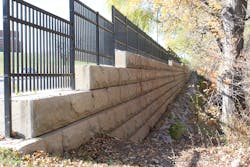A Q and answer
A host of difficult elements combined to require extreme engineering to solve a gravity wall problem on Q Street between 168th and 180th in Omaha, Neb.
This case entailed adding a lane to and widening a stretch of road over a creek, while retaining the existing road’s elevation. It wasn’t a very large portion of the overall project, but it was for sure the most technical. The section of Q Street in question is very busy, so shutting it down wasn’t an option. It needed to be open to traffic from both directions.
In addition, the soil along the bank of the river was very unstable. But because the existing road constrained available space, adding soil reinforcements would have required working back through two lanes of the existing road. That wasn’t possible. To avoid encroaching on the road and to build the wall in and along the creek, general contractor Vrana Construction of Omaha decided that Stone Strong Systems retaining wall blocks was the best product to accomplish the job.
Leick Landscaping Inc. of Glenwood was tasked with building the wall. Remember, space was tight down in the creek. And while there typically would be a gravel or rock base for the heavy wall, there was none here—just mud and loose dirt. That wasn’t going to hold this wall and road. So workers drove sheet pilings into the earth to create a space in which to work. They installed stabilizing piers and poured concrete over top to create a sturdy base. Those heavy measures were necessary to stabilize the base and the creek. Then they started building the wall.
There was no room for tiebacks, due to the existing road, so engineers used heavy mass extenders to build the gravity wall. They started setting the blocks and filling every core with concrete and rebar for heavy reinforcement. They poured concrete behind the wall, too, to gain more stability. Once they started actually placing the blocks, the project moved fast and smooth.
